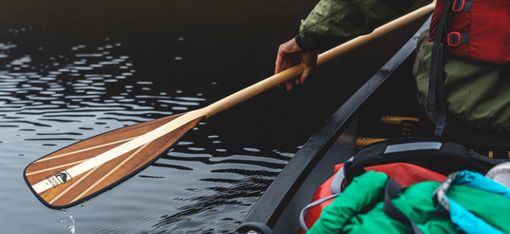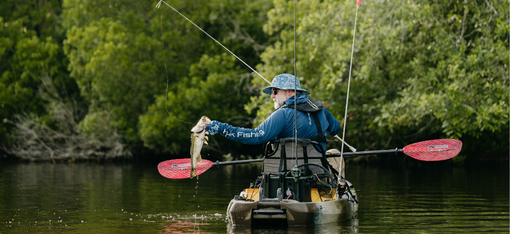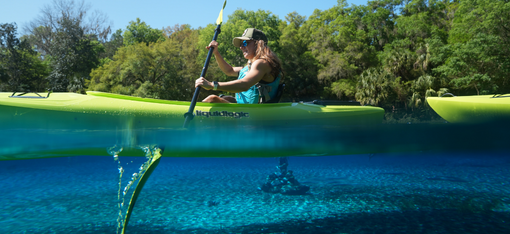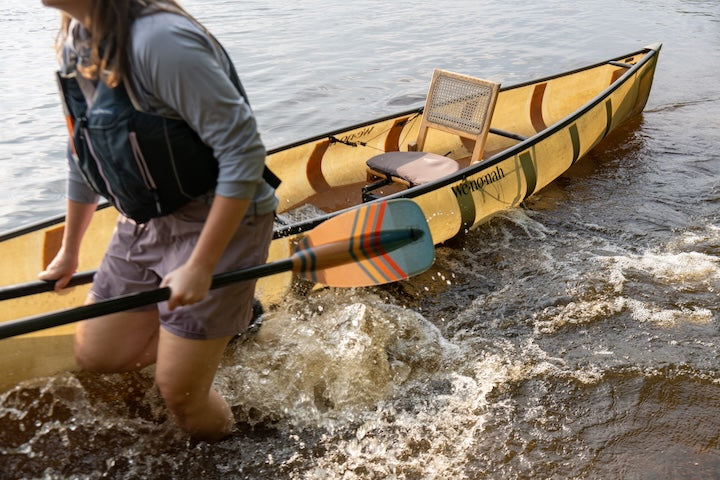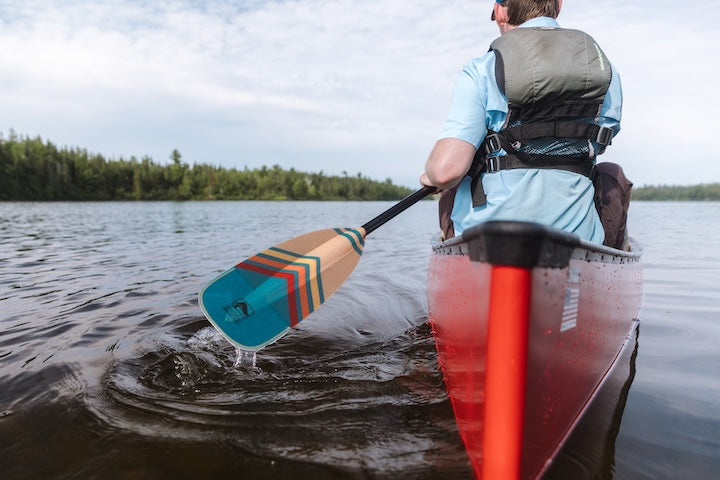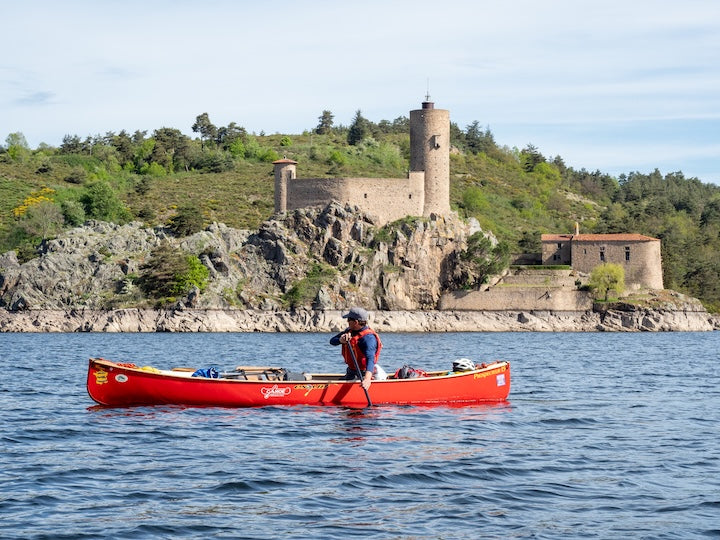Kayak or Canoe: Which Option Suits You Best?
6-minute read
Recreational paddlers might wonder whether they should invest in a kayak or canoe, at least as a first boat. Here are some questions to ask yourself in order to make the best choice for you…

Recreational kayaks are great for one person (photo courtesy of @adventurekayaktours)
Both kayaks and canoes are wonderful ways to get out on the water and paddle. They have their differences, though, that you’ll want to be aware of before you run out and buy one.
Ask yourself these questions and it’ll be easier for you to narrow your focus:
Will You Mostly Paddle Alone or with Others?
If you intend to paddle alone most of the time and are a novice paddler, a recreational kayak will be the easiest to start with. Strokes are easier to learn, the boat is easier to control and maneuver. Maybe you have friends who already kayak and want to join them. Then you’ll want a kayak.
But, maybe you want to paddle with a spouse, a child or a friend? If you see yourself paddling with someone else most of the time, or with more than one child, then a canoe is a better option. A 16 or 17-foot canoe can easily fit a family of five for a day trip if the kids are small. While there are tandem kayaks, they’re limited to two people comfortably.

Canoes are for multiples! (photo courtesy of Nick Wittman)
How Much Weight Do You Want to Haul Around?
Canoes and kayaks are made from a variety of materials and come in a variety of lengths. Both of these factors affect how much a boat will weigh. You know your own strength, where you’ll put it for storage and how you’ll transport it—getting it on a vehicle, getting it to and from a launch site.
When you shop for your boat, be sure to find out its weight before you buy. If you’re comfort limit is 40 pounds, don’t buy one that’s 60 pounds. If you can lift anything, then weight isn’t so much of an issue for you.
Length is also a factor. Solo canoes start at about 12 feet long, while recreational kayaks can be as short as 9 feet. An average tandem canoe is 16-17 feet long.
A good rule of thumb is the longer the boat, the heavier it will be, at least at the recreational budget level. There are much lighter materials used in high-end canoes and kayaks, but those will cost you a lot more.
How Much Storage Space Do You Have?
This is another reason to know the length limit, if any, of a kayak or canoe you purchase. Decide ahead of time where you’ll store it (for longevity, it’s best to store indoors over the winter if you live in the north).
If you don’t have a garage, yard or shed but still love the idea of owning your own kayak or canoe, you’ll want to research inflatable or folding models (more on that below).
Do You Want to Fish from Your Boat?
If you’re an angler and love the idea of fishing from your boat, either a kayak or canoe will work, although ideally the kayak will be a sit-on-top model. Both sit-on kayaks and canoes have lots of storage space for gear that will be easy-access.
If you’ll mostly paddle and fish alone and like the idea of a canoe, you’ll want to look at a solo canoe. They’re shorter and lighter, and the seat is in the middle which makes it easier to control than a full-size canoe.

Both sit-on kayaks and canoes offer lots of room for fishing gear (photo by Reggie Chapa)
How Will You Transport Your Kayak or Canoe?
If you’re buying a boat for the family cabin, or if you live on the body of water you plan to paddle on, you won’t have to worry about this.
But if you’ll need to transport it back and forth to lakes or rivers each time, how will you do that? Does your vehicle already have a rack? Will you invest in a rack designed for kayaks or canoes? Will you be able to lift it up there alone or will you need help?
You can simply use rope (as long as you use reliable knots), or you can invest in tie-down kits for canoes and kayaks.
Do You Want to Take Multi-Day Trips?
Do you love the idea of multi-day paddling trips in wilderness areas? Either option can work, but it depends on your destination and type of water. Since we’re in the American Midwest, we’ll give examples from our area:
The Boundary Waters’ lakes can, of course, be paddled by either a kayak or canoe. But canoes are designed to be portaged by one person while kayaks are definitely not. Canoes can also haul a few hundred pounds of gear, along with people. So if you want to get into areas like the Boundary Waters or Quetico, a canoe is the best choice.
Touring kayaks with water-tight hatches can also be used for multi-day trips, as long as you’ll camp on the same water you paddle, with no portaging (or very short portages). In fact, a good touring kayak is the best option for big water like the Great Lakes.
Should You Go With an Inflatable?
You may or may not be aware that there are many varieties of inflatable and folding canoes and kayaks on the market. Some are in the higher price ranges, but inflatable kayaks, especially, are available for under $1,000.
We don’t suggest a box store brand. Go with a brand that specializes in kayaks, canoes and paddleboards. You’ll get better materials and better reliability.
One of the biggest advantages of these types of boats is their ease of storing and transporting. If you don’t have the space to store a hard-body canoe or kayak, you probably have a car trunk you can put an inflatable in for transport, or some closet space for winter storage.

Tandem canoe (photo courtesy of Harold Born)
What’s Your Budget?
The prices of canoes and kayaks are mostly determined by the materials they’re made from, their length and their features. Low-end recreational kayaks start at around $500, low-end canoes at around $1,000 and high-end of either type can run into the thousands.
Along with the purchase of your boat, you’ll also want to plan to budget in your PFD and your paddle. PFDs designed for kayaking and canoeing are more comfortable than those made for other types of boating, give your arms plenty of freedom and often have D-rings, zip pockets and other handy accessories.
Many people make the mistake of a paddle as an afterthought. “Oh yeah, I need a paddle, too.” But consider: it’s the paddle that’s your motor. It’s the paddle you’re in constant contact with. It’s the paddle you’ll carry all day.
You’ll be much happier with a paddle that’s light, comfortable on your hands, and the correct length for you and your boat. A good paddle will last for decades if you treat it well. So it’s as much part of the buying decision and investment as the boat.
We hope that helps—Happy paddling!
Do you have paddle questions our friendly Customer Service Team can help you with today? Contact them: 715-755-3405 • bbinfo@bendingbranches.com
More for you...




